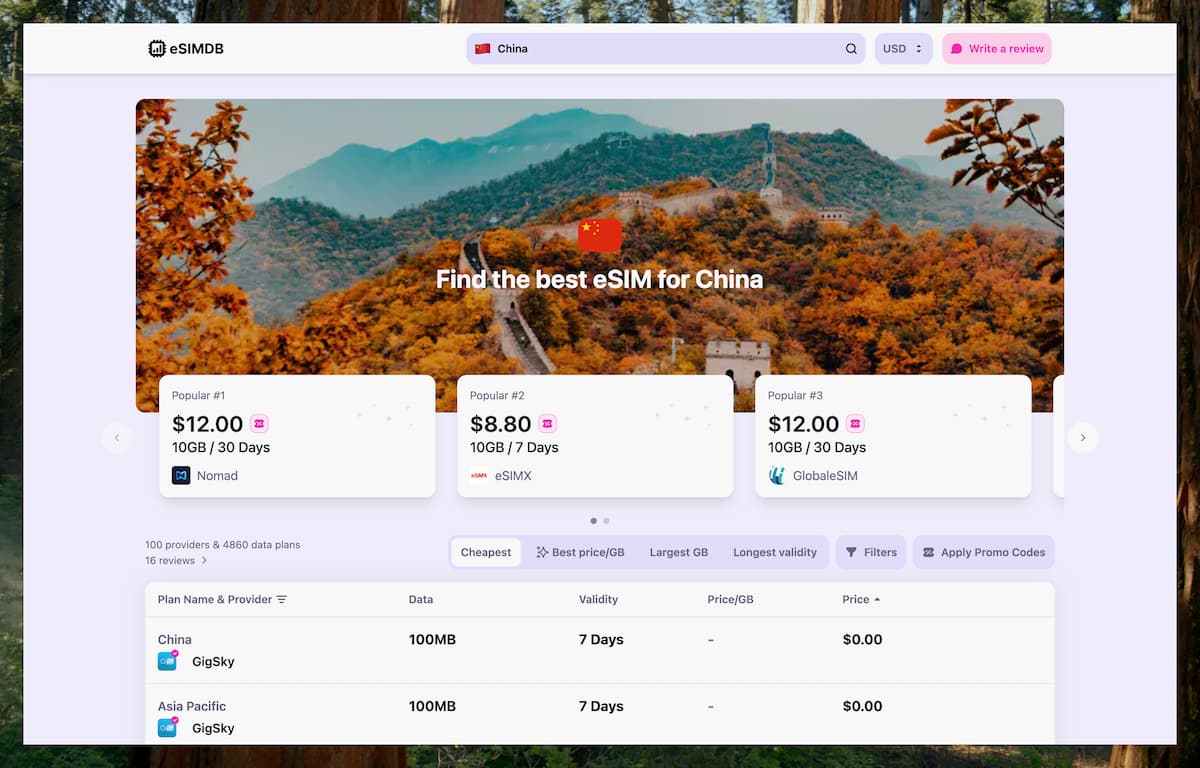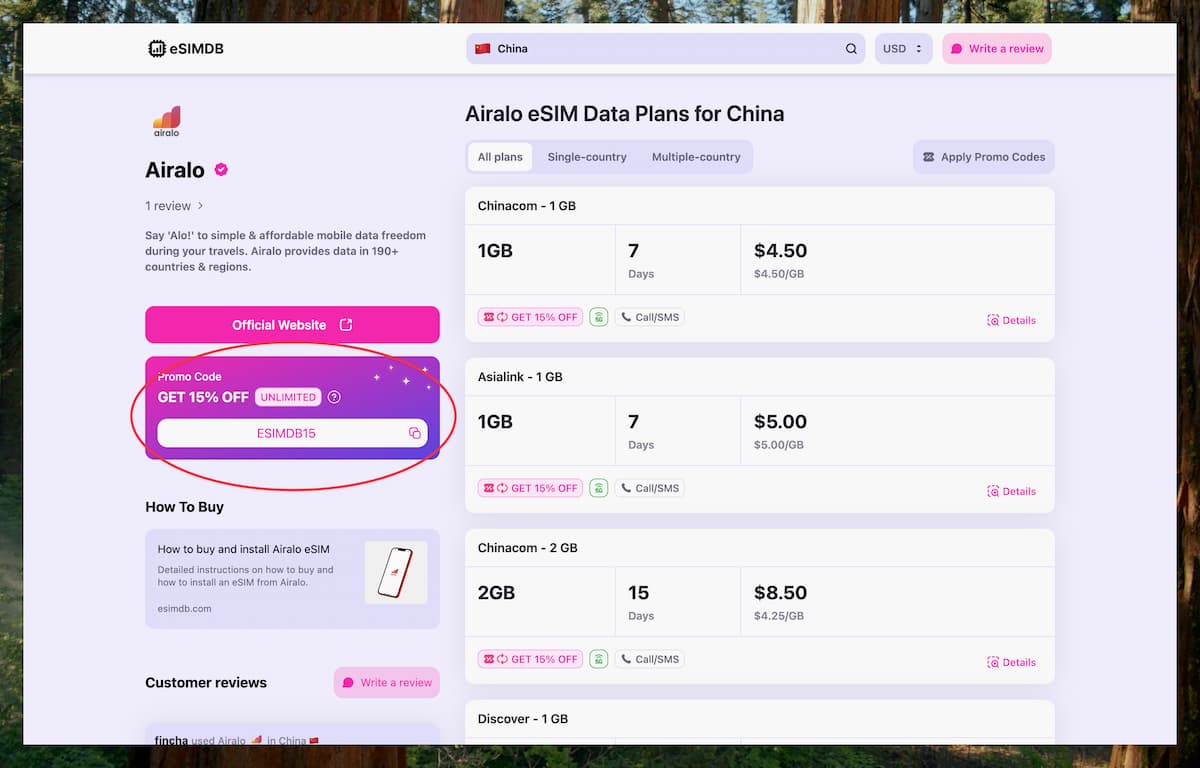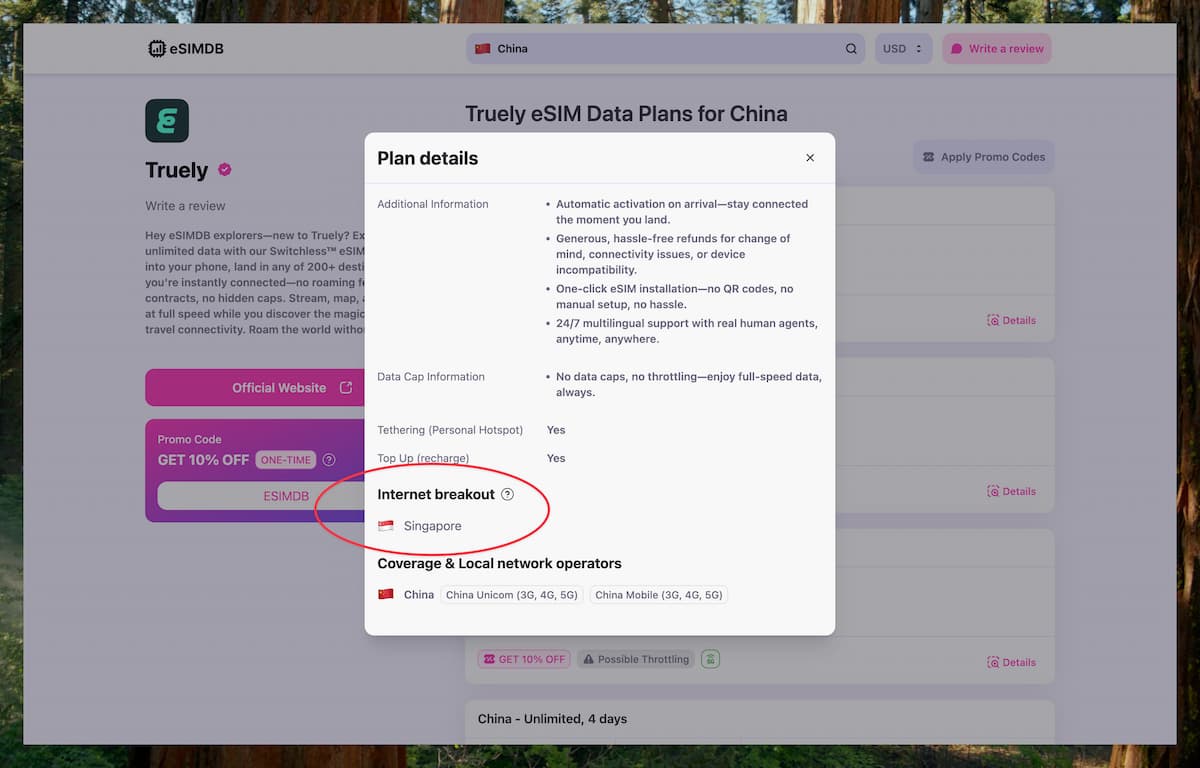Travel eSIM in China: VPN Myths & Great Firewall Explained
This guide reveals how travel eSIMs allow access to social media, Google services, and more in mainland China, and explains the mechanism behind it.

One of the biggest concerns for travelers heading to China, whether for business or vacation, is probably this: Will I still be able to use social media and Google services once I’m there?
The internet today is not only a part of everyday life but also an indispensable tool when traveling abroad. Whether or not certain apps and services are restricted at your destination can feel like a matter of survival for your trip.
This is why it is important to understand how China’s “Great Firewall” works and what to expect from a travel eSIM, especially when it comes to the myths about “built-in VPN”, before your trip. And that’s exactly what this article will cover.
To give you the conclusion first (spoiler alert!): all travel eSIMs currently available for China use roaming connections, so they are not affected by the Great Firewall. In other words, while staying in mainland China, you can use Instagram, X (Twitter), Gmail, and other apps and services just as you would in your own country. This is the central point that I will explain step by step in the rest of this article.
On eSIMDB’s China travel eSIM listings you can find more than 100 eSIM brands and over 4,800 plans. Every single one of them can be used inside China without internet restrictions, without any issues. You do not need to worry about whether it has a VPN or not.
Internet Censorship in China: The “Great Firewall”
As many travelers already know, mainland China places restrictions on access to certain online services and social media platforms. This censorship system is commonly referred to as the Great Firewall. It is essentially a nationwide filtering and monitoring mechanism operated by the government to control domestic internet traffic.

At the time of writing, the following categories of services are blocked in mainland China and cannot be used under normal local connections:
- Google services: Google Search, Gmail, Google Maps, etc.
- Social media: Facebook, Instagram, X (formerly Twitter), etc.
- Messaging apps: WhatsApp, Telegram, etc.
- Video and streaming services: YouTube, Netflix, etc.
- News outlets: New York Times, Bloomberg, Wall Street Journal, etc.
- AI and developer platforms: ChatGPT, GitHub, etc.
For most travelers, many of these apps are part of daily life. Losing access to them can be a major inconvenience.
When connecting through domestic networks in China, whether on hotel Wi-Fi or with a locally purchased SIM card, you will encounter these restrictions. That is because the traffic is routed through Chinese carriers and falls under the scope of the Great Firewall.
On the other hand, internet connections that are routed through servers outside of mainland China (known as roaming connections) are not subject to this filtering. Travel eSIMs for China make use of this roaming system. As a result, users can enjoy internet access in China much like they would at home, without being affected by censorship.
The same applies to international roaming provided by major carriers worldwide. These roaming connections also route traffic out of China first, avoiding the Great Firewall entirely.
As a side note, buying a local SIM card in China is not always convenient. Registration requires presenting official identification, activation may take time, and language or payment barriers can add to the difficulty. For short-term visitors and business travelers, a travel eSIM, international roaming plan, or portable Wi-Fi rental is usually a far easier and less stressful option.
How Travel eSIMs and Roaming Work
Before diving deeper, let’s start with the basics:
eSIM is short for embedded SIM. Instead of swapping a physical SIM card, a travel eSIM allows you to download a mobile plan directly onto a small chip that is already built into your smartphone or device. You can add or switch plans through your phone’s settings, making it much more convenient for international travel.

Roaming connections route traffic outside China
As mentioned earlier, all travel eSIMs for China rely on roaming connections. This means that even though your phone is physically inside China, your internet traffic first connects to servers in another country before reaching the global internet.
For example, imagine you are in Beijing and your travel eSIM is provided by a carrier based in Hong Kong. Even though your phone connects to Chinese cell towers, the data session exits through Hong Kong’s network gateway. In effect, the internet sees you as if you are browsing from Hong Kong, not mainland China. This is why your connection is not subject to China’s Great Firewall.
This setup is common among low-cost China travel eSIMs, many of which use Hong Kong as the roaming gateway. Despite being right next door to the mainland, Hong Kong’s traffic is (currently) not filtered in the same way. One small caveat though; certain apps like ChatGPT may still have restrictions when accessed from a Hong Kong IP address, so keep that in mind.
Roaming location affects network quality
Where your connection exits the country also affects performance. The physical distance between China and the roaming gateway has a direct impact on latency = responsiveness of the connection.
- Closer locations such as Hong Kong, Singapore, or Thailand usually provide smoother and faster performance with less noticeable delay.
- Farther locations like Europe or the United States tend to introduce more latency, which can make websites or apps feel slower to respond.
For casual internet use such as messaging, social media, browsing, the difference is often minor. But if you want the best possible experience, it helps to pay attention to where your eSIM routes traffic. Plans that break out through nearby regions usually provide more reliable connections.

Misunderstandings About eSIMs with “built-in VPN”
Recently, you may have come across travel eSIMs advertised as integrated VPN or VPN included. For travelers who want to use social media or Google services in China, this may sound reassuring. However, in reality, these claims are mostly marketing language rather than a true technical feature.
What is VPN?
VPN stands for Virtual Private Network. It is a technology that encrypts your internet traffic so that it cannot be monitored or tampered with. VPNs work by creating a secure tunnel, encapsulating your data, and assigning you a virtual IP address that hides your real one. This combination can protect your privacy and sometimes bypass regional restrictions or government censorship systems such as China’s Great Firewall.
That said, if the VPN server’s IP address itself has already been blocked by the Chinese authorities, the VPN will not be able to bypass the firewall. In other words, not all VPNs are effective inside China.
What “Integrated VPN” really means for travel eSIMs
When you see travel eSIMs labeled as “built-in VPN” or “VPN included”, what they usually mean is simply that the eSIM uses roaming connections routed outside of mainland China. Because the traffic exits through another country, censorship does not apply. The eSIM itself does not contain or run a VPN client inside your phone.
The phrase can be misleading, right? It gives the impression that the eSIM has built-in VPN technology, when in fact it is just the same roaming system explained earlier.
(Technically, it would be possible to configure an eSIM profile with VPN settings at the APN level, but this is not what current travel eSIMs are doing.)
To put it simply:
- Travel eSIMs do not have an actual VPN function.
- The reason you can access Google, Instagram, or WhatsApp in China is because of roaming, not because of VPN.
- Whether or not the provider advertises “VPN included”, the result is the same: all China travel eSIMs bypass the Great Firewall through roaming.
When you might still want a VPN app
While roaming alone is enough to bypass censorship, you may still want a VPN app for other reasons. For example, you may need to appear as if you are in a specific country, or you may want additional privacy protection. In that case, you can simply install a VPN app on your device and use it on top of your travel eSIM connection.
Just remember: roaming already solves the censorship issue. A VPN app is an optional extra, not a requirement for using social media or Google services in China.
Summary: How to Choose a Travel eSIM for China
As we have seen, all travel eSIMs for China currently available on the market use roaming connections. This means that even when you are in mainland China, your internet traffic is routed through another country. Because of this mechanism, you can use Facebook, Instagram, WhatsApp, Google Maps, Gmail, and other services in China exactly as you would back home, without being restricted by the Great Firewall.
And to repeat the key point: you do not need to worry about whether the eSIM includes a VPN feature. The “VPN-equipped eSIM” label is simply marketing. In reality, every China travel eSIM bypasses censorship through roaming, so no matter which one you choose, you will not face internet restrictions inside China.
What to focus on when choosing a travel eSIM
So, what should you actually look at when comparing eSIM plans? Here are the basic but most important factors:
- Data allowance: How many GB (gigabytes) are included? Choose based on how often and for what purpose you will be using the internet.
- Validity period: How many days does the plan last? Make sure it matches your travel schedule.
- Price: Is it within your budget, and does it provide good value compared with alternatives like roaming from your home carrier or portable Wi-Fi rental?
By focusing on these simple points, you can select the right plan without being distracted by unnecessary marketing terms.
If you want to be extra careful, you can also check the roaming gateway country. Plans that route through nearby regions such as Hong Kong or Singapore generally offer smoother connections. This is not essential, but it can make a small difference in speed and responsiveness.
A note on “Unlimited Data” plans
Many China travel eSIMs are advertised as unlimited data, but in reality, most of them apply speed throttling once you use a large amount of data. For that reason, unlimited is not always the best choice in my opinion. A large but fixed data bundle often gives you clearer limits and more reliable speed.
Since eSIMs can be purchased and activated online anytime as long as you have internet access, topping up or buying an additional plan is easy. If you run out of data, you can simply purchase another eSIM. For heavy users, it often makes more sense to choose a high-capacity data plan upfront rather than relying on “unlimited” promises that may come with hidden slowdowns.
In short: pick a plan with enough data, make sure it covers your travel days, compare the price, and do not overthink the VPN label. That is all you really need to make the best choice for your trip.
Find the Best Value China eSIMs on eSIMDB
Finally, let’s look at how you can efficiently find a cost-effective eSIM plan for China using eSIMDB, the world’s largest travel eSIM search and comparison platform.
On the China travel eSIM listings page, you will find over 100 eSIM brands and more than 4,800 individual plans available at the time of writing. All of these plans rely on roaming connections that exit through countries outside of mainland China. That means you can use services like WhatsApp, Google Maps, and Gmail without worrying about censorship.

Use filters to narrow down results
eSIMDB includes a filter function that lets you quickly narrow down your options based on the criteria that matter most:
- Data allowance: choose how many GB you need
- Validity period: select plans that last long enough for your stay
- Price: filter by maximum budget
For example, you can set conditions such as “at least 1oGB”, “valid for 5 days or more”, or “under 20 USD” and instantly see only the plans that match your requirements.

Save more with promo codes
Many providers listed on eSIMDB offer discount codes. These can be especially useful if you want to try out a brand you have never used before.
Some codes even have no usage limits, meaning you can apply them every time you purchase.

Be sure to check the details on the plan page before you buy.
Check roaming breakout locations
Not every eSIM plan shows this information, but some list the internet breakout location under “Plan Details” > “Internet breakout”. This tells you where your internet traffic is exiting to the public internet.

While this detail is more advanced, it can help you predict performance:
- Singapore: stable quality with minimal delay
- Hong Kong: usually the lowest latency, although some apps like ChatGPT may have regional restrictions with Hong Kong IPs
- Poland or the United States: longer physical distance, so latency may feel higher
If you want the most comfortable browsing experience, it is worth checking this information before purchasing (or ask your eSIM provider directly).
That’s all—pack your bags, load your eSIM, and go enjoy China!

